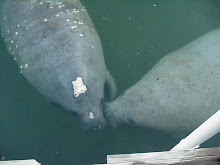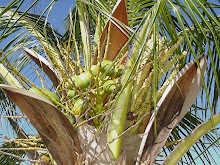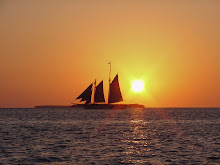The last time (April of this year) The Colonel and I took another vacation to Savannah, Georgia (one of our favorite places to visit), we also took a day trip to Daufuskie Island. South Carolina.
Daufuskie Island is the southernmost inhabited sea island in South Carolina and is located between Hilton Head Island and Savannah. It is 5 miles long by nearly 2-1/2 miles wide. The island is surrounded by the waters of the Calibogue Sound, the Intracoastal Waterway and the Atlantic Ocean. It is accessible only by ferry or barge.
We woke up early in the carriage house we were staying at in Savannah and drove about one hour to the ferry dock. The ferry's departure was set for 7am. The ferry ride to Daufuskie Island took roughly one hour. The water was not choppy and the ride was comfortable.
We pulled alongside the island's dock, disembarked the ferry and began the walk to the island on a long pier. As we were walking, two of the passengers who rode with us, a middle-aged black woman and her young son, walked near us and were met with hugs and kisses from an older black woman (she was the mother/grandmother of the passengers). We smiled at them and the older woman said welcome to Daufuskie Island (more about her later).
There are not many cars on the island and most people get around via golf cart or bicycle. We choose the golf card route. The island is after all 5 miles by 2-1/2 miles in size (I do not think my legs or backside could handle all that bike riding). We picked up our fully-charged, electric golf cart and after a quick instruction on its operation, we were off to explore the island (with map in hand).
Most roads on the island are unpaved and are shaded by ancient, moss-covered oak trees. It was beautiful and quiet as we toured the island.
Daufuskie Island is home to just over 400 full-time residents. There are environmental preserves, private communities, resorts, Gullah houses, a winery, a lighthouse, art and history galleries on the island. Daufuskie Island was named an historic district on the National Register of Historic Places due to its Gullah and Civil War history. The Gullah are African Americans who live in the Lowcountry region of the the United States. They still maintain some of their African culture and have a distinct creole language.
These are some of the Gullah cottages on the island.
There were a couple of churches on the island.
There were two school buildings on the island. One was the first little school for the African American children on the island and then the bigger school was built to take its place in the early 1930s.
The bigger school house is the one that was immortalized in Pat Conroy's book, The Water is Wide. He was a teacher there for a year (!969-1970). Below are some pictures of Pat Conroy from the time he was a teacher at the school. The pictures were hung in the school's windows. The Colonel and I wished to go in but the building was closed. The school building now houses an art shop/studio and a coffee shop,
The Colonel and I walked up to the the back door of the school and ordered some coffee through the window. While we were waiting for our coffees, I saw some books for sale. Pat Conroy's book,
The Water is Wide and another from the local named Sallie Ann Robinson.
Sallie Ann Robinson is a cookbook author, a celebrity chef and a cultural historian. She is a native of Daufuskie Island and noted for her knowledge of the Gullah traditions and history. Sallie Ann was also one of the students that Pat Conroy taught when he was on the island. The character Ethel in Pat Conroy's book,
The Water is Wide, is based on Sallie Ann. Remember the black woman I spoke of earlier, the one we met on the pier coming onto the island?...she was Sallie Ann Robinson.
The Colonel and I had watched the movie Conrack (based on The Water is Wide) before our vacation. It was one of the reasons we wanted to visit Daufuskie Island, so it was exciting for us to actually run into one of Mr. Conroy's students and to see the school building where he taught.
The Colonel and I zipped up and down the island in our electric golf cart, ever mindful of how much power reserves we had. The little red bars on the dash kept us informed. We stopped by the winery and the lighthouse.
If you look closely at the above photo, you may see the light of the lighthouse.
We took a lunch break during our travels around the island. We wanted to eat at Lucy Bell's but it was closed so we ate at Old Daufuskie Crab Company at the Freeport Marina. The food and service were good and we had a nice water view.
After lunch, we hopped back into our golf cart and visited other parts of the island. We saw the Oyster Union Society Hall. The oyster business was huge on the island and the canned oysters were shipped to many cities in the U.S. The oyster business declined in the 1950s due to pollution from the Savannah River.
We visited a couple of the seven Gullah cemeteries on the island. All Gullah cemeteries are near water. The Gullah belief is that the water will carry the spirits of the dead back to Africa.
We walked a little path to a marshy area of the island and saw some old tabby ruins along the way.
We also stopped by a beach on the island.
It was nearing time to head back to catch the ferry to the mainland, so we got into the golf cart and started back. According to the map, we were a long way from the dock. I looked down at the red bars that indicated how much battery power we had left and it showed about three bars. The man at the golf cart place said that when the bars flash quickly, you are nearly out of power.
The Colonel had every confidence that we would have enough power to make it. I, on the other hand was feeling my blood pressure climb when ever I looked at the bars. The Colonel had the pedal mashed to the floor and it seemed to me that we were crawling at tortoise-like speeds. Every few seconds I would glance at the power bars...now there were only two. We still had more than half of the island to go. I kept looking at the map and then looking at the bars...one bar left. I was sure we would run out of power and miss the ferry.
The Colonel remained calm. The red bar began to flash and we still had a little ways to go...it began to flash quickly...where was that dock? Finally, with a red bar flashing out a rapid S.O.S. we pulled into the golf cart place and the man who worked there looked at the flashing bar with disbelief. He had never seen one of his carts that low on power after it had been used for the day. Whew...I was just glad to be back at the dock.
People were lining up on the dock awaiting the ferry. One woman had an interesting pet perched on her shoulder.
I forget now what the opossum's name was but I do remember it was a female. The woman said she had been orphaned as a tiny baby so she raised her.
The ferry ride back to the mainland was uneventful.
The Colonel and I enjoyed our visit to Daufuskie Island very much. One more thing checked off the Bucket List.
















































































